Cysteine-specific Chemical Proteomics: From Target Identification to Drug Discovery
DOI:
https://doi.org/10.2533/chimia.2016.764Keywords:
Chemical proteomics, Cysteine-reactive small molecules, Mass spectrometry, Natural products, Proteomic profilingAbstract
Our laboratory focuses on chemical proteomics-enabled discovery of new cysteine-reactive small molecules with intriguing biomedical activities as well as identification and detailed characterization of their proteomic targets. In this overview article, we summarize our progress since 2013 in this research field. We have developed a novel mass spectrometry-based chemoproteomic method that allows detection and monitoring of up to ~3000 reactive cysteines in any cellular proteome. This is achieved via strategic use of two clickable, cysteine-reactive chemical probes with complementary substrate selectivity profiles, iodoacetamide and ethynyl benziodoxolone. Using this method, we have been able to identify the direct biological targets of curcumin, a diarylheptanoid natural product with anticancer activity, and deoxyelephantopin, a highly cytotoxic natural sesquiterpene lactone. Furthermore, we have developed chloromethyl triazoles (CMTs) as a novel chemical scaffold for cysteine-reactive inhibitors that can be accessed from commercially available substrates in only two chemical steps. From a small collection of chloromethyl triazoles, we have identified compound AA-CW236 as the first non-pseudosubstrate inhibitor of MGMT, a DNA repair protein that renders several devastating cancer forms resistant to chemotherapy.Downloads
Published
2016-11-30
Issue
Section
Scientific Articles
License
Copyright (c) 2016 Swiss Chemical Society

This work is licensed under a Creative Commons Attribution-NonCommercial 4.0 International License.
How to Cite
[1]
Chimia 2016, 70, 764, DOI: 10.2533/chimia.2016.764.







